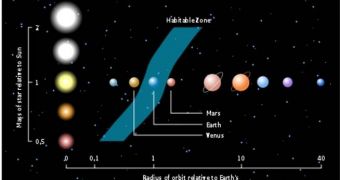The habitable zone around a star is regularly considered to be the area in which water could exist in liquid form. For example, the Earth is situated dead-square in the middle of the Sun's habitable zone, whereas Venus and Mars are just outside of it. While the former is too hot, the latter is too cold, so they do not have liquid water on their surfaces. But this definition of a habitable zone is about to be narrowed down a bit, experts say, with the addition of new limits within which one may be considered.
The main addition to the definition, astronomers share, should be tidal forces. These forces manifest themselves between a planet and its parent star, when the planet is on an orbit that is too close to the star. When this happens, the planet becomes tidally locked, in very much the same way our Moon is locked to Earth, meaning that it will always keep the same face oriented towards its center of gravity. If this is the case, then chances of it being able to support liquid water become slimmer and slimmer.
On the one hand, the face oriented towards the star will most likely be too hot to allow for liquid water to form, while, on the other hand, the dark side may be too cold to allow for the melting of ice. In the case of our planet, the fact that Earth is revolving around its axis within 24 hours is a very important factor in determining the heat that it retains when one of its halves is oriented away from the Sun, during the night. Heat is radiated at relatively the same levels across the surface, and the atmosphere helps a lot.
However, we are lucky to be living next to a yellow dwarf. Most other stars close to us are red dwarfs, and, as such, they give away a lot less heat and light. This means that their habitable zones are much closer to their surfaces, and only planets inside them are able to support life. But such a proximity implicitly means tidal locks, and astronomers believe that the enthusiasm some have, when they believe that more red dwarfs mean more chances of finding life, is not entirely justified.
“Overall, the effect of this work is to reduce the number of habitable environments in the universe, or at least what we have thought of as habitable environments. The best places to look for habitability are where this new definition and the old definition overlap. The bottom line is that tidal forcing is an important factor that we are going to have to consider when looking for [a] habitable planet,” University of Washington astronomy postdoctoral researcher Rory Barnes, who is also the lead author of a new paper detailing the finds, to be published in an upcoming edition of The Astrophysical Journal Letters, said.

 14 DAY TRIAL //
14 DAY TRIAL //